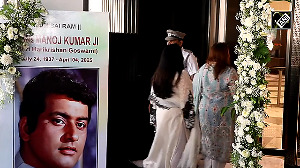'It was like the skies would open for me every time we spoke.'
'Every conversation with him was illuminating and edifying.'
'Jaise ki aasman khul gaya ho, taaron se bhara hua, Chandni se bhara hua.'

Back then they called it 'art cinema'.
And it wasn't said in a flattering way.
Art Cinema was synonymous with boredom.
That's where Kumar Shahani came in.
Shatrughan Sinha, who played a pivotal role in Mr Shahani's Kasba, says the classification of cinema as 'art' and 'massy' was very damaging to serious cinema.
"I personally never followed these segregations in cinema. To me there was only good and bad cinema.And I've done my share of both. If I've worked with Manmohan Desai and Subhash Ghai I've also worked with Goutam Ghose and Kumar Shahani."
Speaking of his experience with Mr Shahani, Mr Sinha recalls, "I think Kasba had me in a grey role, neither good nor bad just... human! That's the most difficult to play. Kasba featured other fine actors like M K Raina, Manohar Singh, Mita Vashisht and a very fine actor named Navjot Hansra. I remember Kumar Shahani as a very sensitive film-maker with whom one could converse about anything," recalls Mr Sinha.

No actor had the tuning with the avant garde director that Mita Vashisht did, not even Smita Patil with whom Mr Shahani did arguably his best, most accessible film Tarang.
With the magnificent Mita, Mr Shahani did the daunting Khayal Gatha the haunting Kasba. In both Mita is beyond stunning.
"No even before these two films, he and I did a short film together," Mita corrects me. "It was called Vaar Vaar Vaari. I once wrote an essay entitled Kala Hans in Hindi about the art of Kumar Shahani. I think that essay really speaks about the amazing director that he was... Right now I feel a deep sense of loss. My first film, Vaar Vaar Vari from which my journey began, was a Kumar Shahani short film. It is on YouTube and I strongly recommend it."

"Main abhi tak unke saath touch mein thi," she continues after a ruminative pause. "We used to have serious conversations -- one couldn't dare have frivolous chats with him -- which lasted from 45 minutes to 90 minutes."
"We used to talk about any and every subject, on art on cinema, on life. His was no ordinary mind. He was so amazingly connected to the technological advancements in the world of cinema, digital media, everything...
"He had this unique insight into the pros and cons of all cinematic technology. He would tell me about the endless potential of the digital media and that it is not being utilised properly."
Mita says each and every conversation with Kumar Shahani is etched in her memory. "It was like the skies would open for me every time we spoke. Every conversation with him was illuminating and edifying. Jaise ki aasman khul gaya ho, taaron se bhara hua, Chandni se bhara hua."
Mita was all set to work again with Mr Shahani. "We were trying to set up a play together, a project he had envisioned with me in lead and Vikram Joglekar as the sound designer. But that was not meant to be (her voice brims over). But I will try to make it happen the way he would have liked it to be."

Interestingly Kumar Shahani's most accessible work Tarang was offered to Shabana Azmi who suggested Smita Patil was a better choice for that particular part.
Mr Shahani wanted Rameshwari instead, but finally signed Smita for Tarang.













 © 2025
© 2025